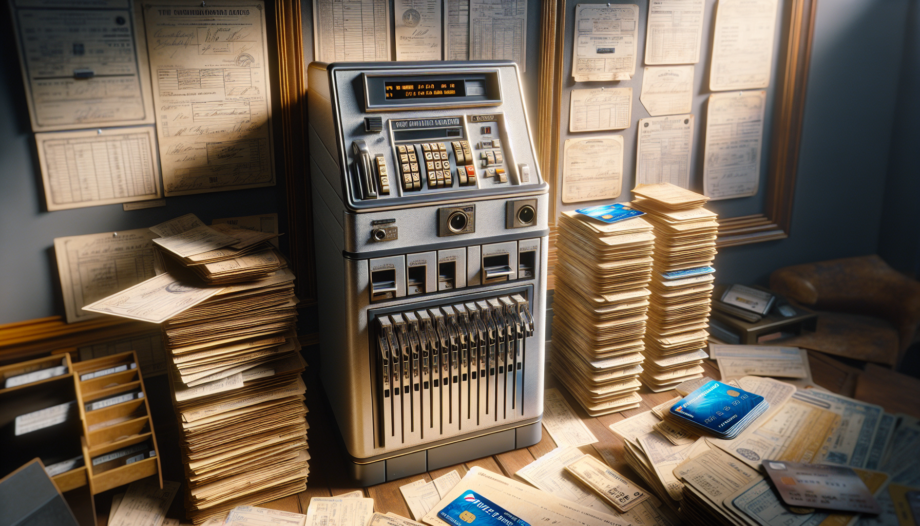Debit cards have become an indispensable part of our daily financial transactions, offering convenience, security, and instant access to our bank accounts. But have you ever wondered about the origins of these plastic wonders? In this article, we’ll take a trip down memory lane to explore the fascinating history of debit cards, from their humble beginnings to the high-tech marvels we use today.
The Birth of Debit Cards: A Game-Changer in Banking
The concept of debit cards first emerged in the late 1960s, revolutionizing the way people accessed their money. Instead of writing checks or carrying large amounts of cash, debit cards provided a faster and more secure way to make transactions directly from a bank account.
While the idea was groundbreaking, it took some time for the technology to catch on due to its infancy. Banks needed to invest in infrastructure and educate customers about this new payment method, which was a gradual process.
The Pioneering Role of Bank of Delaware in 1966
The Bank of Delaware made history in 1966 by piloting the first debit card program. This pioneering move laid the foundation for the widespread adoption of debit cards in the years to come.
Although the Bank of Delaware’s debit card was a significant milestone, it was ahead of its time. The technology was still in its early stages, and it would take several more years for debit cards to gain traction among consumers and merchants.
Early Challenges and Gradual Adoption
Despite the potential benefits of debit cards, their adoption was not immediate. The technology was still in its infancy, and banks needed to invest in infrastructure to support this new payment method.
Additionally, consumers needed time to understand and trust debit cards. Many were hesitant to link their bank accounts directly to a plastic card, fearing security risks or unauthorized transactions.
However, as banks continued to improve debit card technology and educate customers about its benefits, widespread adoption slowly began to take hold. By the 1980s, debit cards had become a more common sight in wallets across the United States.
The Evolution of Debit Cards: Milestones and Advancements
As debit cards gained popularity, they underwent significant changes and improvements. From the introduction of bank-specific ATMs to the adoption of electronic chips for enhanced security, debit cards have evolved to keep pace with changing consumer needs and technological advancements.
Introduction of Bank-Specific ATMs in the 1970s
One of the first major milestones in the evolution of debit cards was the introduction of bank-specific ATMs in the 1970s. These machines allowed customers to withdraw cash using their debit cards, providing a convenient alternative to visiting a bank teller.
ATMs played a crucial role in increasing the accessibility and usability of debit cards. Customers could now access their money 24/7, making debit cards a more attractive option for everyday transactions.
Adoption of Electronic Chips for Enhanced Security in the 1990s
As debit card usage grew, so did concerns about security. To address these issues, banks began adopting electronic chips in debit cards in the mid-1990s. These chips provided an extra layer of security, making it more difficult for fraudsters to counterfeit cards or steal sensitive information.
The introduction of chip technology marked a significant advancement in debit card security. It helped to boost consumer confidence in using debit cards for everyday purchases, further driving their widespread adoption.
Modern Debit Cards: Convenience and Technology at Your Fingertips
Today, modern debit cards are a far cry from their early predecessors. With features like contactless technology, integration with digital wallets, and advanced security measures, debit cards have become essential tools for managing our finances in the digital age.
Contactless Technology for Quick and Easy Transactions
Contactless debit cards have revolutionized the way we make quick transactions. By simply tapping your card on a payment terminal, you can complete a purchase in seconds, without the need to swipe or insert your card.
This technology has made easy payments more accessible than ever before. Whether you’re grabbing a coffee on the go or paying for groceries, contactless debit cards have streamlined the transaction process, saving time and hassle.
Integration with Digital Wallets for Seamless Payments
In recent years, debit cards have also become closely integrated with digital wallets like Apple Pay, Google Pay, and Samsung Pay. This integration allows users to make seamless payments using their smartphones or smartwatches, without the need to physically carry their debit card.
Digital wallet integration has further enhanced the convenience and accessibility of debit cards. Whether you’re shopping online or in-store, you can now make secure payments with just a few taps on your mobile device.
Debit Cards vs Credit Cards: Key Differences and Benefits
While debit cards and credit cards may look similar, they operate in fundamentally different ways. Understanding the key differences between these two payment methods can help you make informed decisions about which one to use in different situations.
Drawing Directly from Your Bank Account vs Borrowing Money
One of the main differences between debit cards and credit cards is how they access funds. When you use a debit card, you’re drawing money directly from your bank account. In contrast, when you use a credit card, you’re borrowing money from the card issuer, which you’ll need to pay back later, often with interest.
This distinction has important implications for your financial management. With a debit card, you can only spend money that you already have in your account, which can help you avoid overspending and accumulating debt. Credit cards, on the other hand, can tempt you to spend more than you can afford, leading to high-interest charges and potential debt issues.
Lower Fees and Reduced Risk of Overspending
Another key benefit of debit cards is that they often come with lower fees compared to credit cards. While some debit cards may charge monthly maintenance fees or ATM withdrawal fees, these costs are generally lower than the annual fees, interest charges, and late payment fees associated with credit cards.
Additionally, using a debit card can help reduce the risk of overspending. Since you’re limited to the funds available in your bank account, you’re less likely to make impulse purchases or rack up large bills that you can’t afford to pay off.
The Future of Debit Cards: Fintech Innovations and Beyond
As technology continues to evolve, so too will the world of debit cards. Fintech innovations are already transforming the way we use and interact with our debit cards, and the future promises even more exciting developments.
Biometric Authentication and AI-Driven Fraud Detection
One area where fintech is making significant strides is in security. Biometric authentication, such as fingerprint or facial recognition, is becoming increasingly common as a way to verify transactions and prevent unauthorized access to accounts.
Additionally, AI-driven fraud detection systems are being developed to analyze spending patterns and flag suspicious activities in real-time. These advanced technologies can help protect consumers from identity theft and fraudulent transactions, providing an extra layer of security for debit card users.
The Potential for Crypto-Style Debit Cards
Another exciting development on the horizon is the potential for crypto debit cards. As cryptocurrencies like Bitcoin and Ethereum gain mainstream acceptance, some companies are exploring the idea of creating debit cards that allow users to spend their crypto holdings directly, without the need to convert them into traditional currency first.
While still in the early stages, crypto debit cards could revolutionize the way we think about money and transactions. They could provide a bridge between the traditional financial system and the growing world of digital assets, making it easier for people to use and benefit from cryptocurrencies in their daily lives.
From their humble beginnings in the 1960s to the high-tech wonders we use today, debit cards have come a long way. They’ve transformed the way we access and manage our money, offering convenience, security, and control at our fingertips. As fintech innovations continue to shape the future of banking, one thing is clear: debit cards will remain an essential part of our financial lives for years to come.
See also:

